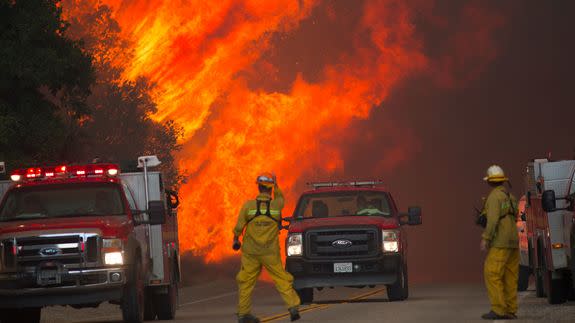Massive wildfire near Los Angeles kills one person, forces thousands to flee

The massive wildfire encroaching on Los Angeles has killed at least one person and forced thousands of people to flee their homes, fire officials said.
What began as a brush fire last Friday rapidly morphed into a raging blaze over the weekend, burning more than 33,000 acres and destroying at least 18 homes in Los Angeles County.
SEE ALSO: Raging 'Sand Fire' casts apocalyptic glow over Los Angeles
Skies filled with thick black smoke, brightened only by bursts of red and orange rising above the canyon ridges. Unexpected winds on Sunday reenergized the blaze and stirred up fire tornadoes that jumped across the area.
Only about 10 percent of the wildfire was contained by Sunday night, the Los Angeles County Fire Department reported.
“All the experience we’ve had with fires is out the window,” John Tripp, the county’s deputy fire chief, told the Associated Press.
Fire officials are investigating the death of a man who was found Saturday in a burned sedan outside a house in the fire zone, according to AP.
At least 10,000 homes and 20,000 residents were advised to evacuate over the weekend, and the flames are threatening to engulf around 200 commercial buildings.
Fire Chief Daryl Osby said that triple-digit temperatures, high winds and bone-dry forest conditions helped fuel blaze that is still threatening a string of communities near Santa Clarita, a city about 40 miles northwest of Los Angeles.
“This is the fifth year of an ongoing drought, so we have very extreme fire behavior,” Osby told reporters Sunday at a news conference.
Human-caused global warming is at least partly to blame for California’s persistent drought and rash of intensifying wildfires, climate scientists say.
Average temperatures in the Golden State have crept up by 2.5 degrees Fahrenheit over the last century as greenhouse gas emissions soar, according to a 2015 study from Columbia University’s Lamont-Doherty Earth Observatory in New York.
That extra heat is sucking moisture from California’s plants and soil. The dried-out ground exacerbates the already-parched conditions caused by natural cyclical weather patterns and a staggering lack of rainfall in recent years, the Columbia researchers found.
As California and nearby states turn into hot, dry tinder boxes, wildfires are striking with more frequency and intensity.
“These are not normal times,” Fire Chief Osby told reporters.
